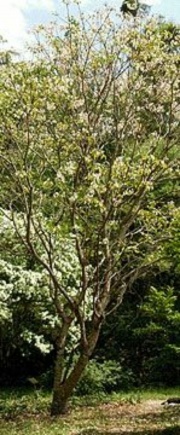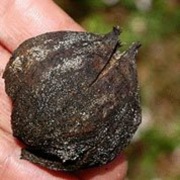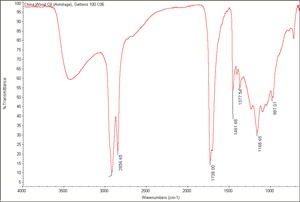Difference between revisions of "Tung oil"
(username removed) |
|||
| (4 intermediate revisions by 3 users not shown) | |||
| Line 1: | Line 1: | ||
| − | [[File:vfordiinewform.jpg|thumb|Tung oil tree | + | [[File:vfordiinewform.jpg|thumb|Tung oil tree ''Vernicia fordii'']] |
| − | |||
| − | ''Vernicia fordii'']] | ||
== Description == | == Description == | ||
| − | A strong, tough drying oil expressed from the seeds of the tung trees, Vernicia fordii (''Aleurites fordii)'', indigenous to the mountain regions of China. Since the 1920's, tung trees have been cultivated in Florida, California and Australia. Unlike many other drying oils, tung oil contains [ | + | A strong, tough drying oil expressed from the seeds of the tung trees, Vernicia fordii (''Aleurites fordii)'', indigenous to the mountain regions of China. Since the 1920's, tung trees have been cultivated in Florida, California and Australia. Unlike many other drying oils, tung oil contains [[oleic%20acid|oleic]] (4.1%) and eleostearic (90.7%) fatty acids. Tung oil polymerizes rapidly to form a yellowish, hard, waterproof, wear resistant film; thick coatings may wrinkle and cool temperatures may produce a tacky surface. Tung oil is most often used for spar varnishes, wood finishes, floor sealers; [[oil%20cloth|oil cloth]], and oil-based paints. It is also used in the production of [[linoleum|linoleum]]. Tung oil is not used as an artist paint medium but it has been added in small amounts to [[casein|casein]] emulsions. |
| − | + | [[File:vfordiileaf2.jpg|thumb|Tung oil tree ''Vernicia fordii'']] | |
| − | [[File:vfordiileaf2.jpg|thumb|Tung oil tree | + | [[[SliderGallery rightalign|China Wood Oil (Armitage), Gettens 100.C06.TIF~FTIR (MFA)]]] |
| − | |||
| − | ''Vernicia fordii'']] | ||
== Synonyms and Related Terms == | == Synonyms and Related Terms == | ||
''Vernicia fordii (Aleurites fordii); Aleurites cordata; Aleurites montana''; aceite de tung (Esp.); olio di Tung, olio di Aleurites (It); wood oil; Chinawood oil; China-wood oil; Chinese wood oil; crystal China wood; tang oil; teak oil | ''Vernicia fordii (Aleurites fordii); Aleurites cordata; Aleurites montana''; aceite de tung (Esp.); olio di Tung, olio di Aleurites (It); wood oil; Chinawood oil; China-wood oil; Chinese wood oil; crystal China wood; tang oil; teak oil | ||
| − | == | + | == Risks == |
| − | |||
| − | |||
| − | |||
| − | |||
| − | + | * May cause skin irritation. | |
| − | + | * Combustible. | |
| − | + | * Parchem: [https://www.parchem.com/siteimages/Attachment/GHS%20Tung%20Oil%20MSDS.pdf SDS] | |
| − | |||
| − | |||
| − | |||
| − | |||
| − | |||
| − | |||
| − | |||
| − | |||
| − | == | + | ==Physical and Chemical Properties== |
| − | + | * Liquid oil is soluble in chloroform, ether, carbon disulfide, oils. | |
| + | * Dried film is insoluble in most solvents. | ||
| + | * Saponification number = 191-196 | ||
| + | * Iodine number = 150-175 | ||
| + | * Acid value = 0-12 | ||
| + | * Melting Point = -2.5 C | ||
| + | * Density = 0.936-0.943 | ||
| + | * Refractive Index = 1.517-1.530 | ||
| − | == | + | ==Resources and Citations== |
| − | * ''Encyclopedia Britannica'', http://www.britannica.com Comment: "Tung Oil." | + | * ''Encyclopedia Britannica'', http://www.britannica.com Comment: "Tung Oil." Accessed 14 Apr. 2004 . |
| − | * | + | * Virginia Tech Dendrology website at www.fw.vt.edu/dendro/dendrology/main.htm (accessed Oct. 8, 2005) - current name = Vernicia fordii (synonym to Aleurites fordii) |
| − | * | + | * USDA Plants Database at http://plants.usda.gov/cgi_bin/topics.cgi?earl=plant_profile.cgi&symbol=VEFO Scientitic name= Vernicia fordii (synonym = Aleurites fordii); tree is on Invasive Plant List for U.S. |
* R. J. Gettens, G.L. Stout, ''Painting Materials, A Short Encyclopaedia'', Dover Publications, New York, 1966 | * R. J. Gettens, G.L. Stout, ''Painting Materials, A Short Encyclopaedia'', Dover Publications, New York, 1966 | ||
| Line 51: | Line 42: | ||
* Ralph Mayer, ''A Dictionary of Art Terms and Techniques'', Harper and Row Publishers, New York, 1969 (also 1945 printing) | * Ralph Mayer, ''A Dictionary of Art Terms and Techniques'', Harper and Row Publishers, New York, 1969 (also 1945 printing) | ||
| − | * | + | * Handbook for Energy Crops by James Duke, 1983. at http://www.hort.purdue.edu/newcrop/duke_energy/Aleurites_fordii.html |
* Thomas B. Brill, ''Light Its Interaction with Art and Antiquities'', Plenum Press, New York City, 1980 | * Thomas B. Brill, ''Light Its Interaction with Art and Antiquities'', Plenum Press, New York City, 1980 | ||
Latest revision as of 14:23, 21 June 2022
Description
A strong, tough drying oil expressed from the seeds of the tung trees, Vernicia fordii (Aleurites fordii), indigenous to the mountain regions of China. Since the 1920's, tung trees have been cultivated in Florida, California and Australia. Unlike many other drying oils, tung oil contains oleic (4.1%) and eleostearic (90.7%) fatty acids. Tung oil polymerizes rapidly to form a yellowish, hard, waterproof, wear resistant film; thick coatings may wrinkle and cool temperatures may produce a tacky surface. Tung oil is most often used for spar varnishes, wood finishes, floor sealers; Oil cloth, and oil-based paints. It is also used in the production of Linoleum. Tung oil is not used as an artist paint medium but it has been added in small amounts to Casein emulsions.
Synonyms and Related Terms
Vernicia fordii (Aleurites fordii); Aleurites cordata; Aleurites montana; aceite de tung (Esp.); olio di Tung, olio di Aleurites (It); wood oil; Chinawood oil; China-wood oil; Chinese wood oil; crystal China wood; tang oil; teak oil
Risks
- May cause skin irritation.
- Combustible.
- Parchem: SDS
Physical and Chemical Properties
- Liquid oil is soluble in chloroform, ether, carbon disulfide, oils.
- Dried film is insoluble in most solvents.
- Saponification number = 191-196
- Iodine number = 150-175
- Acid value = 0-12
- Melting Point = -2.5 C
- Density = 0.936-0.943
- Refractive Index = 1.517-1.530
Resources and Citations
- Encyclopedia Britannica, http://www.britannica.com Comment: "Tung Oil." Accessed 14 Apr. 2004 .
- Virginia Tech Dendrology website at www.fw.vt.edu/dendro/dendrology/main.htm (accessed Oct. 8, 2005) - current name = Vernicia fordii (synonym to Aleurites fordii)
- USDA Plants Database at http://plants.usda.gov/cgi_bin/topics.cgi?earl=plant_profile.cgi&symbol=VEFO Scientitic name= Vernicia fordii (synonym = Aleurites fordii); tree is on Invasive Plant List for U.S.
- R. J. Gettens, G.L. Stout, Painting Materials, A Short Encyclopaedia, Dover Publications, New York, 1966
- M. Doerner, The Materials of the Artist, Harcourt, Brace & Co., 1934
- Reed Kay, The Painter's Guide To Studio Methods and Materials, Prentice-Hall, Inc., Englewood Cliffs, NJ, 1983
- Ralph Mayer, A Dictionary of Art Terms and Techniques, Harper and Row Publishers, New York, 1969 (also 1945 printing)
- Handbook for Energy Crops by James Duke, 1983. at http://www.hort.purdue.edu/newcrop/duke_energy/Aleurites_fordii.html
- Thomas B. Brill, Light Its Interaction with Art and Antiquities, Plenum Press, New York City, 1980
- G.S.Brady, Materials Handbook, McGraw-Hill Book Co., New York, 1971 Comment: p. 825
- Richard S. Lewis, Hawley's Condensed Chemical Dictionary, Van Nostrand Reinhold, New York, 10th ed., 1993
- The Merck Index, Martha Windholz (ed.), Merck Research Labs, Rahway NJ, 10th edition, 1983 Comment: entry 9944
- CRC Handbook of Chemistry and Physics, Robert Weast (ed.), CRC Press, Boca Raton, Florida, v. 61, 1980 Comment: melting point = -2.5, density=0.934, ref. index = 1.5174, iodine value=168.2, saponification value = 193.1; eleostearic acid (90.7%)
- Art and Architecture Thesaurus Online, http://www.getty.edu/research/tools/vocabulary/aat/, J. Paul Getty Trust, Los Angeles, 2000


